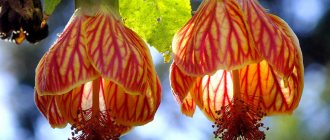Violets have been considered not only one of the most beautiful, but also one of the most popular flower families for many decades and to this day. Our great-grandfathers cultivated them, and we continue to plant them on our balconies. This plant is of no less interest to breeders. And therefore, for all the time that violets have conquered the hearts of people, a huge number of genera, species and varieties have appeared. We will talk about one of them in more detail in this article, and this is the Aphrodite violet.
We will tell you everything: from how to plant, grow and properly care for this lovely flower, to various interesting facts and the best varieties of the magnificent Aphrodite violet.
Did you know?
This flower was first studied and described by a famous German botanist named Walter Saint-Paul. This discovery, which truly changed the world of botany and floristry, was made in 1892. By the way, the flower itself is often called by the name of its creator, namely Saintpaulia. However, you may well have not heard this interesting name for violet.
Violet Aphrodite: description of the plant
Violet Aphrodite: photo of the variety
Violet Aphrodite is a herbaceous and perennial plant, and therefore you do not have to bother with planting new seeds or seedlings every season. The stem is significantly shortened, which can be observed by examining other violet-like flowers. From them, and there are quite a lot of them, by the way, a basal rosette is formed, on which delicate and beautiful leaves are formed.
As for the general dimensions of one individual bush, they can be estimated from twenty to thirty centimeters. At the same time, it should be noted that they remain quite wide, since the width of the rosette almost always coincides with the length of the stems, and sometimes exceeds it. If we talk about the leaves, it should be noted that they have a very geometrically regular shape in the form of a circle, which is slightly pointed at the end.
Speaking about color, you can pay attention to the fact that it is not constant and varies from species to species and from variety to variety. However, most often the leaves of this plant acquire a bright green color. Some species are distinguished by the presence of small villi. The root system of the Aphrodite violet is quite large, reliable and strong. In addition, it has a huge number of branches, and therefore the plant sits very firmly in the ground.
In addition to the stems, the rosette also develops, of course, flower stalks, on which what the plant is immediately loved for is formed - flowers, which can reach up to nine centimeters in diameter. In addition, they are very lush and terry. Violet inflorescences are not particularly dense or lush. However, even two or three of these flowers, collected together, look very beautiful.
Speaking about the petals, it should be noted that they, like the leaves of the plant, have a circular shape. However, unlike the leaves, Aphrodite's petals are wavy and their shade varies much more than the leaves. For example, scientists have long bred hybrids with pink petals. There are also varieties that are painted in almost all shades of blue: from violet and purple to blue and even cyan. You can also find almost snow-white violets.
It should also please those who do not like to care for a flower throughout the year only for it to bloom for only a week. Aphrodite violet blooms almost throughout the entire year, but, of course, some periods are much more active and effective. Of course, such months are all the summer months, as well as spring and autumn. During all this time, it is simply impossible to take your eyes off the flowers.
In winter, their number decreases significantly, but, nevertheless, the plant continues to delight the eye with its beauty. As for the number of flowers, it, of course, varies greatly, depending on the variety, species or subspecies. However, if we give average values, we can say that the number of flowers rarely exceeds a hundred, but never less than fifty. In any case, there will definitely be enough of them to easily decorate any place.
By the way, you probably noticed that we very often mention various types and varieties of violets, among which there are both natural and hybrid ones. However, of course, they are all descendants of one of the wild species of violets. In order to meet it, you will have to visit the wild tropical forests of Africa, which is currently considered not only the native, but also the only home of this plant, since no data has yet confirmed the presence of this plant anywhere else.
As for Aphrodite itself, it was bred through selective breeding thanks to Russian breeders, thanks to whom it is still considered one of the best existing types of violets. In addition, there are a huge number of hybrids, the ancestor of which is the Aphrodite violet, which already speaks of the popularity and quality of this flower.
Botanical description of the plant
Violet Aphrodite is a perennial herbaceous plant from the Violet family. Its stem is greatly shortened, forms a basal rosette from which numerous leaves grow. The average length of the plant is in the range of 20–30 cm, while the diameter of the rosette can be about 20 cm. The leaves are dense, smooth, rounded and slightly pointed at the edge, with petiole-type stipules. The color of the leaves is often rich green; they also have numerous fibers. The root system of the plant is fibrous, creeping, and highly branched.
From a common rosette near the stem, peduncles also develop, on which flowers are formed. The flowers are double, up to 9 cm in diameter, bisexual, double perianth. They gather in small inflorescences of several pieces. The petals of the flower are wavy, round in shape, their color shade is varied. There are hybrids with pink, blue and lilac shades. Violet can bloom throughout the year, so the active period of flower growth is often about 9 months. From 50 to 100 flowers bloom simultaneously on one plant.
Like all Violets, the plant in question is a long-standing descendant of various wild forms living on the African continent, so this territory is still considered the natural habitat of the flower. The variety itself is a product of the modern Russian breeding school, various hybrids of which were born at the beginning of the 21st century.
Among them, the following varieties have been successfully registered:
- SK Aphrodite - hybrid of A. Kuznetsov, the plant is quite miniature, distinguished by numerous small flowers of a delicate lilac color;
- EK Aphrodite — the author is E. Korshunova, the variety is distinguished by dark blue flowers with a thin white border;
- ATM Aphrodite - bred by M. Krutov, characterized by light lilac flowers with a bright lilac border.
How to grow violet variety Aphrodite at home
Violet Aphrodite: photo of the variety
In fact, you should not have any difficulties with growing the Aphrodite violet variety at home. This plant grows very well in the room, and this is despite its rather large flowers. In the end, the dimensions of the flower certainly cannot be called huge, and therefore the Aphrodite violet fits perfectly on any windowsill.
However, in order for the Aphrodite violet not only to exist in your home, but to actually grow, bloom and enjoy life, you will have to provide it with conditions very close to those in which it grows in the wild. Otherwise, the plant, although it will not die, will feel very sluggish, and the flowers will appear in extremely scanty quantities and in dim colors.
Did you know?
In ancient Greece, violets brought from hot countries were used not only as an ornamental house plant, but also as cult flowers. They were often used to decorate temples and churches. In addition, violets were very often brought to sculptures and monuments, and, accordingly, a gift in the form of this plant was considered very expensive and prestigious.
How the violet Aphrodite reacts to light
Not only is your technique for growing this plant incredibly important, but even where it is located. However, we are unlikely to surprise experienced gardeners with this fact, but for beginners who decide to cultivate such a difficult plant to care for, it will be very useful to know the following.
Despite the fact that plants seem to love the sun very much, an excess of its radiation can be very, very harmful for them. Especially for delicate violets, on the surface of which very unpleasant burns may well appear. To prevent this from happening, you need to very wisely choose the place to plant the flower.
Namely, now we are talking about the orientation of the window, since the lack of light is also unlikely to have a good effect on the Aphrodite violet variety growing in the back of the room. Under no circumstances should you plant it on a south window, since there it will constantly be exposed to huge doses of ultraviolet radiation, and even if it seems to you that it is not so hot and bright there, it is better not to risk it.
In the end, you are not a flower and do not live on a windowsill, and therefore judging solely by your feelings is not the best idea. A much better choice would be a window with a western or eastern orientation.
South-eastern or south-western directions may also be suitable, but northern windows, on the contrary, are of little use for violets: there will be too little light there, and the plant will be very lethargic and frail.
Temperature and humidity
Absolutely all violets are quite sensitive to the temperature in which they grow, and therefore the violet Aphrodite was no exception. However, its thermophilic nature only means that it does not tolerate cold, and does not mean that it should be kept at temperatures below thirty degrees Celsius.
In fact, you can easily apply the following rule to violets: if the room is comfortable for you, then it will be comfortable for them too. This means that the temperature, logically, should be room temperature (from twenty to twenty-five degrees).
On the one hand, a slight upward change in temperature will not lead to dire consequences. On the contrary, a decrease in temperature can lead to inhibition of flower growth and development, and there is also a high risk that violet flowers will not bloom at all.
Therefore, you should not neglect the temperature regime, although small deviations are obviously not fatal. As for humidity, it should not be too high, despite the fact that this is extremely unintuitive, because the flower grows in tropical forests.
However, fifty to seventy percent moisture content in the air should be sufficient. For successful moisturizing, you can purchase a special sprinkler that will carry out this procedure without your participation at all.
However, those who like to care for flowers themselves can use a spray bottle. However, in this case, try to ensure that too large drops of water do not fall on the flower - this may harm it.
Photo
Violet SK-Aphrodite, A. Kuznetsov. Photo by S. Sazykina (blooming in the heat):
Flowering in cool weather:
Violet SK-Aphrodite, A. Kuznetsov, photo by Comrade Lysikov
Basic rules of care
Violet Aphrodite: photo
In order for the Aphrodite violet variety to grow conveniently and comfortably in your home, you should follow not only the above instructions for arranging its place of residence, but also provide it with good care and attention. However, it should be noted that many gardeners consider violet to be a rather unpretentious plant.
This may, of course, be true, however, if you are still new to this business, you may well have serious difficulties and questions while working with this flower. Therefore, we present to you detailed instructions on how to prevent the Aphrodite violet from not only growing on your window for a long time, but also blooming successfully and never getting sick. Once you become familiar with it, care will truly become an easy and relaxed task, for which the flower will reward you with its beauty and radiance.
Watering the Aphrodite violet variety
In order to water your violet only when it needs it, you will need the ability to observe and analyze the moisture content of the substrate. The fact is that this flower, like most others, requires a golden mean, in which the ground is not too waterlogged, which can cause root rot, but also not too dry, which is why the plant itself will dry out.
Therefore, unfortunately, it is very difficult to define any clear watering dates. It all depends on the humidity of the substrate. And it depends on how hot it is outside, how quickly the flower drinks, and so on. However, we will still try to give an approximate watering schedule in absolutely moderate weather: it is expected to be twice a week (once every 3-4 days), but this value may vary.
For example, if it has been hot for several days, the next watering should be postponed for a couple of days, but if it was quite cool, then watering can be postponed for a while. And, of course, do not forget to carefully monitor the substrate. However, only at first this procedure seems difficult and incomprehensible. Within a month or two, you will be able to easily navigate when the plant needs to be watered, and when it is better to refrain from doing so.
According to completely different rules, however, watering is carried out in winter. The fact is that at this time the plant is much less active and spends much less energy, and therefore, of course, it needs much less water. Consequently, watering is reduced to once a week.
Helpful advice: If you are completely unsure about when to water your violet, we advise you to do the following: wait until the surface of the substrate is completely dry and water it very generously. After this, do the same thing several more times, simultaneously recording how long it takes to dry the soil, and how much it depends on external conditions.
After a few such weeks, stop exhausting the plant and water it a day or two before a dry crust is expected to appear on the surface of the soil mixture. Of course, the amount of watering needs to be reduced a little.
This way you can develop your own watering schedule, which will be ideal for your plant. However, most likely, it will not be too far from what we proposed, and therefore experiment only if you are confident in your actions.
Now let's talk about the watering method. Here we are faced with much fewer complex nuances and uncertainties, since the procedure is extremely simple and the most important thing in it is to try not to get the leaves and flowers too wet. A watering can with an oblong spout will help you with this, ideal for watering flowers with dense foliage that blocks direct access to the ground.
Stop watering if and only if excessive moisture begins to emerge from the drainage holes. If you overdo it and there is too much of it, we recommend that you drain the excess.
As for water for irrigation, everything is pretty standard. Of course, you can’t just draw water from the tap and water the flower with it. The water must be heated to ambient temperature and allowed to stand for a day (or less).
Violet Aphrodite: feeding
Violet Aphrodite: photo
Violet Aphrodite is a rather sensitive plant to fertilizers, and therefore they are used mainly only in liquid form. Of course, you will find a lot of information that some gardeners are completely comfortable using solid fertilizers, but we still advise you to avoid them.
By the way, there is another limitation regarding fertilizers. And, to be more precise, it concerns their concentration. The fact is that manufacturers indicate the recommended concentration of the drug is not for such delicate flowers as violets, and therefore it is advisable to reduce it by half.
As for the frequency of fertilizing violets, during the active growing season this is done once every one and a half weeks. On the other hand, during the dormant period, fertilizers should be completely abandoned.
Important! The above rules do not apply if you have just transplanted the plant. And this does not depend at all on when the transplant took place.
Regardless of whether the plant is in its most active growth period or in a dormant period, fertilization is completely stopped for five to six weeks. Otherwise, the violet may simply not cope with the circumstances and die.
Trimming
Violet Aphrodite is a perennial ornamental plant, which means that pruning it is simply necessary. Of course, this reasoning is only valid if you want your bush to be beautiful and have a large number of flowers, since it is pruning that ensures its proper growth and development.
Also, pruning the Aphrodite violet variety is very important to stimulate the growth of flowers. The fact is that if your plant has old or damaged stems, the violet will still spend its strength and energy on them. We don't need this at all. After all, we want her to send all her strength only to healthy and promising flower stalks. This is where the need for pruning comes from.
As already mentioned, it is carried out exactly as needed and does not depend at all on the time of year. Also, as we said, old and damaged stems and peduncles must be removed. It also makes sense to get rid of stems that are too large, as they obviously take too much nutrition and energy from the violet.
More advanced pruning techniques also involve removing parts of the bush that are interfering with the development of other parts of the bush. For example, stems that shade most of the flower with their leaves. Also, in addition to everything that was written above, you should follow the following pruning rules, which will help you not harm the plant during this procedure.
First of all, it is worth remembering that the plant can also become infected with bacteria or viruses, which can lead to extremely unpleasant consequences. Therefore, your goal is to try your best to prevent this by using only clean tools and treating the cut areas with charcoal.
In addition, the tool must be sharp so that you can remove the stem with just one cut. Otherwise, scars will form on the damaged tissues, which will definitely not help healing. When removing excess leaves, you should also remove their stems along with them, and when removing an entire stem, it is not at all necessary to leave small stubs: if you cut it, then completely - under the rosette.
The only period when pruning is not recommended at all is the dormant period, since the procedure carried out at this time can greatly harm the plant. Also, before the onset of this very period, it is advisable to carry out the last pruning, which involves thinning the bushes and getting rid of all faded flower stalks.
Violet Aphrodite - replanting the plant
Violet Aphrodite: photo
Violet Aphrodite is not one of those plants that can constantly live and grow in the same pot, such as cacti. She constantly feels cramped in her home, and therefore your task as an experienced and attentive gardener is to provide her with comfortable housing. The procedure is carried out one to two times a year, depending on how quickly the root system of the flower becomes crowded in its pot.
However, conducting it at random is not the best idea. The fact is that replanting, of course, is a huge stress for the plant, which it can only survive at a favorable time - in summer or spring.
An autumn transplant can lead to serious complications, and a winter transplant can even destroy the flower. It is also important to remember that a transplant is an excellent opportunity to carry out another procedure – rejuvenation. Of course, it makes no sense for a one-year-old flower to carry it out, but a violet that has lived for two or three years already needs it. This procedure consists of removing all old stems and shoots. Essentially, this is selective pruning.
Important! During replanting, many gardeners love to deepen the plant, but we assure you that this is not the best idea. At least when we're talking about violet. Under no circumstances should the rosette go deeper into the ground than it was in the previous pot. Otherwise, it will be very difficult for the flower to adapt.
The transplant procedure itself is carried out according to the following rules, which must be followed.
The bush must be removed from the substrate along with the earthen lump. Otherwise, you run a very high risk of damaging the root. It is advisable to remove the old primer and use new one. Of course, this does not apply to the earthen coma surrounding the roots, but the new soil will still greatly help the plant to take root in the new pot. This is necessary because over time the soil inevitably becomes poorer and in order to prevent the unpleasant consequences of this, we renew the soil in the pot.
After this, a new pot, already purchased and prepared for replanting, is filled one third with new soil mixture and the violet with an earthen lump is placed in it. All cracks are filled very carefully and tightly until no gaps remain. This is very important, since otherwise the plant will not be provided with the necessary reliability, and over time it may well simply collapse.
By the way, we talked so much about the new substrate, but we didn’t say a word about how to prepare it. To do this you will need the following ingredients: peat, turf, vermiculite, leaf soil. You can also spread crushed sphagnum moss on the surface, which will help you prevent the soil from drying out. However, if you are not confident in your abilities, you can buy a ready-made soil mixture for ornamental crops at any garden store. You probably won’t notice a big difference in quality, but you will save a lot of time.
Also, before planting, you need to do some additional manipulations with the soil, namely, fertilize and loosen. As for the pot, it should be significantly larger than the previous one. If the root was already too cramped in its previous home, the size of the pot can be increased up to five centimeters relative to the previous one.
Basic rules for caring for violets
Although Violas are considered unpretentious plants, growing Aphrodite on a windowsill is not so easy. In addition to watering and periodic fertilizing, the bushes need to be pruned and replanted in a timely manner: without this, extending their life cycle for the next season will be quite problematic.
Watering
When watering violets, it is necessary to create moderate humidity in the substrate. Prolonged waterlogging of the soil is detrimental to the roots of the flower, so the pots are often watered abundantly, but not more than 1-2 times a week. In winter, moisturizing is reduced to 1 procedure per week. The plant's acute need for moisture is determined using the state of the substrate: it is moistened after the appearance of a distinct dry crust about 1–2 cm thick.
Flowerpots are watered by overhead method, but drip irrigation is not recommended. Water must enter the soil, bypassing the leaves and rosette, otherwise waterlogging of the green mass will lead to the creation of a favorable environment for the development of fungi. Water the soil until excessive moisture comes out of the drainage holes. For irrigation, use only clean, settled and filtered water heated to ambient temperature.
Find out more about the features of watering violets at home.
Feeding
To achieve long-lasting flowering from Aphrodite, as well as bright and rich colors of flowers, flowerpots need to be fertilized periodically. For this purpose, complex mineral mixtures are used, based on phosphorus, nitrogen and potassium, as well as all kinds of microelements. Most often, specialized fertilizers for violets or complex preparations for flowering plants are used for this purpose.
Fertilizers are often applied only in liquid form, but if necessary, foliar fertilizers can also be used: for this, the concentration recommended by fertilizer manufacturers is halved. Regardless of the type of fertilizing, during the active growing season, violets are fertilized every 10–14 days. However, during the rest period the described procedures are not carried out.
Important! After transplantation, fertilizing the substrate is stopped for 4–6 weeks. During this period, the introduction of concentrated preparations can cause yellowing, wilting and even death of the bush.
Trimming
Since the cultivation of Aphrodite involves the decorative maintenance of the plant, it is subjected to periodic pruning - this will make it possible to form a compact and graceful bush. In addition, removing excess parts of the stem allows you to direct all the plant’s forces to the formation of flowers, which only improves its decorative value.
Pruning is carried out as necessary; excessively large, as well as excess parts of the bush that shade each other, old and dried leaves must be removed. Taken together, this measure makes it possible to rejuvenate the bush, improve its productivity, and also stimulate flowering.
Violets are pruned no more than once a month based on the following recommendations:
- Only clean and disinfected instruments are used for the procedure;
- pruning is carried out only with a sharp instrument; plucking is prohibited, as it damages the delicate tissues of the plant;
- the leaves are removed along with the cuttings, large parts of the bush are removed in rosettes;
- the last shortening of the season is carried out before the onset of the dormant phase - at this time the bushes are thinned out and removed from faded flower stalks;
- The cutting areas must be treated with crushed charcoal - this will protect the flower from specific infections.
Video: trimming violet leaves
Transfer
Violet transplantation is carried out as the bush grows, 1-2 times a year. The most suitable period for this is spring or summer: this is how the plant best adapts to new conditions. In the case of transplanting a mature plant (2–3 years or older), it is rejuvenated during the procedure. To do this, the rhizome and rosette are thoroughly cleaned of old parts.
Important! It is not recommended to deepen the violet during transplantation.
-
the socket must remain at the same level relative to the soil as in the old pot.
The procedure is carried out using transshipment:
- The bush is carefully removed from the pot along with the root ball of the substrate.
- If possible, part of the old soil is removed. As the flower grows, the soil becomes depleted, as well as the accumulation of various toxins in it, so this measure will not only ensure improved development of the bush, but will also protect it from immune suppression.
- Next, the violet, along with a lump of earth, is transplanted into a new container, one-third filled with new soil.
- After this, all the cracks are carefully filled with soil, and then the pot is well moistened.
Transplant the flower into pots with a well-fertilized and loose substrate. To prepare it, mix peat, turf soil, vermiculite, leaf soil, sand and sphagnum moss in equal parts. The new pot should be 1–5 cm larger in diameter than the old one; it can be made of any non-toxic material (ceramics, plastic, etc.).
Video: how to transplant a violet
Violet Aphrodite: propagation at home
Violet propagation by leaf
Many novice flower growers think that propagation by any non-seed method is an incredibly complicated and confusing operation, but this is not at all the case. In fact, if you thoroughly understand the essence of the process, you may not encounter any difficulties at all.
Most often, when propagating Aphrodite violets, they resort to one of these three methods: leaves, stepsons or peduncles. However, you can also propagate it by seeds, but with this, oddly enough, you will have much more difficulties and problems. And the germination rate will not be nearly as impressive as one might think.
As for the timing, they should be the same as for transplantation, since both of these procedures are quite similar in nature. You separate a plant (or part of a plant) from its usual habitat and force it to adapt to a completely different and unfamiliar one.
If we are talking about popularity and ease of execution, then the leaf propagation method is undoubtedly ahead of all, and therefore we will consider it first and discuss all the nuances of its implementation.
Reproduction of Aphrodite violet by leaf
First of all, we, of course, need a piece of paper. You need to choose it very carefully, since, in fact, it is in a good, healthy and large leaf that almost half of the success of the entire operation lies. After the leaf has been selected, it should be cut off very carefully and carefully, while treating the cut area with crushed charcoal.
After this, it should be placed in warm water or soil for some time. After such a “bath”, the leaf should be in a dry and warm place. There he can put down little roots. When this happens, the leaf can be transplanted into its own pot.
Soon the leaf will develop a stronger and more durable root system, which will be able to produce shoots and after some time will turn into a full-fledged adult plant. In addition, the planted leaf requires minimal care, and therefore this method is the simplest and, at the same time, the most effective.
Reproduction of the Aphrodite violet variety by stepsons
This method of propagating violets is in second place in popularity, and it is carried out exclusively during pruning.
In order for the future bush to be healthy and strong, it is necessary to choose a young and undamaged part of the flower, which in the future can develop well and turn into a full-fledged violet.
Other characteristics that the stem you choose must have is the presence of at least three equally healthy leaves, which will indicate that no problems will arise during cultivation, and the leaves will also help receive the sun’s energy for growth.
In order for the cut stepson to take root well, you will have to plant it in a pot full of vermiculite. However, for the same purposes you can use both well-fertilized soil and water. In such an environment, the stepson remains for a week, after which it is transplanted into its own pot, where it will be cared for in the same way as an ordinary adult plant.
Reproduction of Aphrodite violet by peduncles
An important rule when propagating violets by peduncles is that only those parts of the plant that have already bloomed and will not have buds are selected. Of course, the peduncle on which the largest and healthiest flower grew is chosen.
This peduncle is cut off, and the cut site itself must be treated with charcoal. Further, the process is very similar to reproduction by stepchildren. The peduncle is grown in water or moist soil for a week or two, where roots should form. As soon as this happens, the seedling is planted in its own pot, where it is provided with proper care.
Propagation of Aphrodite violet by seeds
As already mentioned, this method of Aphrodite’s reproduction is far from the most popular. In principle, one could even say that he is the most unpopular, and there is a very logical reason for this.
The fact is that this process is incredibly long and complicated, and therefore not everyone will have sufficient professionalism and skills to simply complete this procedure, not to mention carry it out effectively. In addition to the gardener's own skills, this operation also requires very strict adherence to the natural growth conditions of violets, which are sometimes simply impossible to achieve at home.
In addition, you will have a lot of trouble with the seeds, since they are very poorly stored and are very fragile. First of all, they will have to be soaked in water, after which their shells will be covered with ash, and only then they can be sown. However, if you are still a skilled enough grower to do all this, then you will have to directly sow the seeds.
They are planted in rows to a depth of about two centimeters. In this case, the distance between any two seeds should be from three to five centimeters. After planting is completed, the container is covered with glass or film, which will provide protection to the seedlings.
The temperature of the content is also very important, and therefore the container with the seeds must be moved to a place where the temperature does not drop below twenty-four degrees. However, they should not be fried either, and therefore temperatures above twenty-eight degrees are also undesirable. After the shoots appear, and at least half of them have two to three leaves, the cover can be removed and all the shoots can be planted in their own pots.
However, we remind you that this method is highly undesirable for beginners, and therefore we advise you to avoid it until you are ready and confident in your abilities. However, if you have a lot of free time, you can test your strength in this way, but only as an experiment.
Difficulties in growing
In principle, if you follow all the rules for caring for a flower and do not make serious mistakes, then you should not have any problems. However, none of us is immune from accidents or from our own stupidity, and therefore sometimes we still have to eliminate unwanted problems.
We have tried to compile a list of the most frequently encountered problems and provide methods for resolving them.
The first and most common problem that gardeners face when growing not only Aphrodite violets, but also when growing absolutely any pile of violets is various forms of rot. They appear due to a fungus that develops very actively in an excessively humid environment. Of course, you already understand what we are talking about.
Yes, this problem occurs with excessive watering, and therefore the best method of dealing with it is prevention, which involves reasonable and proper watering. However, if the problem has already arisen, then, of course, you will not leave the plant to the mercy of fate.
First of all, of course, it is necessary to eliminate the source of the disease, and, therefore, reduce watering within reasonable limits. Next comes the removal of infected areas and treatment of the plant with fungicides. However, unfortunately, sometimes it is not possible to respond to the problem in time, and there is nothing left to do except destroy the infected flower.
The next thing you may encounter is the same putrefactive lesions , but this time not on the root, but on the foliage and stem . It is much easier to notice them, and therefore it is also easier to take countermeasures.
The main cause of the disease is a disease called late blight. It appears when the soil is contaminated. Therefore, the first thing you should do is transplant the plant into a new pot and completely fill it with new soil mixture.
It will also be useful to treat the plant with a drug called “Fitosporin”, which will provide you with confidence that the disease will not return soon.
The next problem, which occurs somewhat less frequently, is white spots on the foliage. This can only happen for one reason, and it is called powdery mildew . Unfortunately, preventing the attack of this disease is an extremely difficult task, but it is quite easy to fight it.
It is enough just to treat the entire bush with the drug “Fitosporin” we have already mentioned. By the way, if some leaves look too damaged, it is advisable to get rid of them.
The last problem, but far from least important, is all kinds of insects and parasites . Unfortunately, you cannot hide from them by simply taking good care of your plant, and therefore the only thing left to do when they attack is to counterattack.
Almost any insecticide that will easily drive away the attack will help you with this. However, it is not necessary to resort to the use of chemicals. It is quite possible to get by with treatment with a soap solution, but only if there are few insects.
All other problems that may arise during cultivation are either extremely unlikely or will kill your flower so quickly that you won’t even notice it, and therefore you will not be able to deal with them. That's why we didn't include them in the list.











